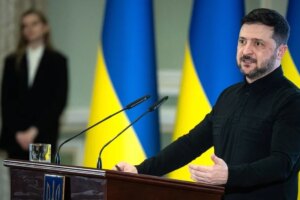
Russia begins using Chinese-made turbojet engines to power glide bombs, the Financial Times says. Ukraine strikes energy facilities in Russia’s Vladimir, Oryol. Russia took 21 months to break through into Pokrovsk, ISW says.
Russia begins using Chinese-made turbojet engines to power glide bombs, FT says
Russia is modernizing Soviet-era “dumb bombs,” turning them into glide bombs capable of hitting Ukrainian targets up to 200km away. Some of the projectiles are powered by Chinese-made turbojet engines, the Financial Times said on Wednesday. The paragraphs below are quoted from the article.
Retrofitted Soviet-era bombs known as KABs have hit targets in the southern Ukrainian regions of Odesa and Mykolayiv, as well as the eastern region of Poltava, for the first time in October. Up until then, the guided projectiles lobbed from Russian Su-34 jets had a range of up to 80km and were used mainly in the proximity of the frontline.
But some of these glide bombs are now fitted with a jet engine — an upgrade that increases their range up to 200km, according to Vadym Skibitsky, the deputy head of Ukraine’s GUR military intelligence service.
Unconfirmed pictures of a KAB that impacted in the Poltava region last month published by Ukrainian electronic warfare specialist Serhiy Beskrestnov showed a Chinese-made turbojet engine that can be purchased for $18,000 on Alibaba.
Pavlo Narozhny, a Ukrainian military expert, said the new Russian weapons were a “cheap substitute for a cruise missile” and were being lobbed at the “same targets: energy infrastructure and military targets”.
The jet engines are just the most recent upgrade to Russia’s KAB arsenal. In 2023, the Russian armed forces started fitting wings and guidance kit on these “dumb bombs” weighing between 250kg and 3 tonnes. That allowed them to glide for dozens of kilometres before exploding and leaving craters up to 20 metres wide and 6 metres deep.
Another jet-powered model reportedly being used is the Grom-E1, an upgrade of the Grom gliding munition. Yuriy Ihnat, a spokesperson for Ukraine’s air force, said that the bomb’s flight characteristics could be “roughly compared” to those of a cruise missile. But, he added: “There is no widespread use of these aerial guided bombs at the moment, the enemy is testing them in combat conditions.” Ihnat said the specifics of the engines’ characteristics were not yet fully known.
But adding jet engines also has drawbacks: it means only smaller payloads of up to 250kg can be used. The bomb could also be jet-propelled for only part of the flight, giving it a boost before it glides towards its target, according to Fabian Hoffmann, a missile expert at the University of Oslo.
The 200km range is in practice limited by the fact that the glide bombs are launched from jets flying well inside Russian-controlled territory to avoid being targeted by Ukrainian missiles or drones.
“The main benefit for Russia appears to be that they can launch the glide bombs from even further behind the frontline, which makes the aircraft delivering them less vulnerable to Ukrainian air defences,” said Hoffmann.
“The concept itself isn’t anything special, the United States has been looking at something similar with a jet-powered JDAM,” he added in reference to the Joint Direct Attack Munition guidance kit that converts unguided projectiles into precision-guided munitions.
Ihnat, the air force spokesperson, said those bombs can be jammed with electronic warfare and downed by anti-aircraft missiles. But air defences are scarce, with Ukraine already struggling to intercept Russia’s massive waves of drone and missile attacks being fired nearly every night and causing power outages in Kyiv and other cities.
Russia has upgraded its ballistic missiles, which are now able to dodge even Patriot interceptors.
Interception rates of Russian missiles dropped from 37 per cent over the summer to just 6 per cent in September, according to a Financial Times analysis of data compiled by the London-based Centre for Information Resilience.
Ukraine’s air defence is also increasingly struggling to shoot down the Iranian-designed Shahed drones, which have benefited from upgrades allowing them to fly faster and at higher altitudes.
The drones’ interception rate decreased from 97 per cent in February to 80 per cent last month, according to Ukrainian air force data compiled by the “Shahed Tracker” monitoring group.
Ukraine strikes energy facilities in Russia’s Vladimir, Oryol
Drones attacked an energy facility on the outskirts of the Russian city of Vladimir overnight on Wednesday, regional governor Aleksandr Avdeyev said. “The response services are working on the site. All utilities operate normally,” he said on Telegram, adding that the services await daylight to address the aftermath of the strike. He also urged the residents to keep calm.
That same night, a combined heat and power plant in Oryol was targeted. Eyewitness accounts described hearing a series of explosions in the city, Russian Telegram channel Astra said. Blasts were audible near a heat and power plant, it added.
The regional governor, Andrey Klychkov, asserted that the city was attacked by drones, all of which were intercepted by air defense systems. “Falling [drone] debris damaged several private homes and an outbuilding,” he said on Telegram. Local residents are convinced that the attack was carried out using missiles, Astra said, aligning the claims with own conclusions that draw on open-source data.
Less than one kilometer from the Oryol combined heat and power plant sits the Oryoltekmash military plant that manufactures equipment used to service and transport military vehicles.
According to earlier reports by the Ukrainian Navy, Ukraine used Neptune cruise missiles to attack the plant in Oryol overnight on October 31. The strikes hit a distribution facility at the plant, cutting power across the city. The city of Oryol and the surrounding region rely on power and heat produced by the plant.
Russia took 21 months to break through into Pokrovsk, ISW says
Russian forces took 21 months to advance 39 kilometers from Avdiivka to Pokrovsk, the Institute for the Study of War (ISW) said in an update on November 4. The paragraphs below are quoted from the report.
Recent Russian advances through Pokrovsk are the culmination of a 21-month campaign to seize the town and a five-month dedicated battlefield air interdiction (BAI) effort to degrade Ukrainian defensive capabilities. Russian gains on the Pokrovsk sector have been in large part enabled by the Russian targeting of Ukrainian drone capabilities. A Ukrainian drone unit operating in the Pokrovsk direction reported that Russian forces are sending nearly 100 fireteams consisting of up to three personnel each into Pokrovsk per day. The Ukrainian drone unit stated that these Russian fireteams are overwhelming Ukrainian positions such that Ukrainian drone operators do not have time to launch drones. Ukrainian military sources have recently reported that Russian infiltration groups are deliberately targeting Ukrainian drone crews to engage them in close combat, inhibiting Ukrainian drone operations. Combined Russian ground tactics and the implementation of BAI effects have created an environment in which it is very difficult for Ukrainian forces to operate drones.
Russian forces took 21 months to advance the 39 kilometers (just over 24 miles) from Avdiivka to Pokrovsk. Russian forces first began the Pokrovsk effort in February 2024 after seizing Avdiivka and began setting conditions to take Pokrovsk through direct frontal assaults in March 2024. This effort failed, however, and Russian forces instead shifted to an envelopment campaign in Fall 2024. Russian forces conducted a short series of assaults in the Pokrovsk direction in Winter 2025 but did not reprioritize the direction again until July 2025. Successful Ukrainian drone operations largely stymied Russian advances in the Pokrovsk direction from late 2024 into summer 2025.
Russian forces began achieving partial BAI effects against Ukrainian GLOCs in the Pokrovsk direction in July 2025, at which point Russian forces effectively denied Ukrainian forces the ability to use Pokrovsk as a logistics hub. Russian technical innovations, such as first person view (FPV) drones with increased ranges, thermobaric warheads, and “sleeper” or “waiter” drones along GLOCs, allowed Russian forces to generate BAI effects and restrict Ukrainian troop movements, evacuations, and logistics. Russia also deployed elite drone operators of the Rubikon Center for Advanced Unmanned Technologies to the Pokrovsk direction and other priority sectors in Donetsk Oblast to focus on interdicting Ukrainian GLOCs and eliminating Ukrainian drone operators.
Russian forces began attempts to infiltrate into Pokrovsk in late July 2025 in tandem with their dedicated BAI efforts in the area. Russian forces achieved a limited penetration northeast of Pokrovsk in the Dobropillya tactical direction in August 2025, likely taking advantage of a porous frontline while seeking to secure the eastern flank of the Pokrovsk direction.
These Russian BAI interdiction efforts have not proven as effective across the entire frontline, however, and will not necessarily be exportable to other parts of the theater. The urban environment in Pokrovsk has provided Russian forces with cover and concealment for infiltration groups and drone crews that are absent in other areas of the frontline, and Russia has dedicated staggering and unsustainable amounts of manpower and materiel to seizing Pokrovsk. Russian forces briefly deprioritized the Pokrovsk effort to focus on the Dobropillya tactical penetration in August 2025. Russian forces failed to exploit this penetration, however, likely in part due to the threat of Ukrainian drone strikes against Russian forces attempting to advance across open terrain. Russian forces then shifted back to prioritizing the Pokrovsk direction by September 2025, and Ukrainian forces have been successfully clearing the Dobropillya salient as Russian forces continue efforts in the Pokrovsk direction as of November 2025. Russian forces have also been attempting to penetrate weak points in Ukrainian defenses and advance near and into Kupyansk, but have not succeeded in destabilizing Ukrainian defenses to the same degree as in Pokrovsk.
The differences between the Russian efforts to seize Kupyansk and Pokrovsk are likely in part due to the open terrain surrounding Kupyansk and Russia’s inability to dedicate the same degree of manpower and resources to offensive efforts in the Kupyansk direction, especially as the Russian effort to collapse the Ukrainian pocket in the Pokrovsk direction is ongoing. Russian forces have also not prioritized generating BAI-type effects in the Kupyansk direction to the same degree as Pokrovsk. Russia would have to commit to potentially years-long, resource-intensive ground operations and BAI implementation to recreate the conditions in Pokrovsk elsewhere in the theater.
Russian forces continue advancing through Pokrovsk. Geolocated footage published on November 3 and 4 indicates that Russian forces recently advanced in northwestern, northern, and northeastern Pokrovsk. Russian milbloggers claimed that Russian forces advanced within, northwest of, and west of Pokrovsk beyond what available geolocated footage indicates. Ukrainian President Volodymyr Zelensky stated on November 3 that there are about 260 to 300 Russian soldiers within Pokrovsk and that 30 percent of all fighting in the theater is occurring near Pokrovsk.





